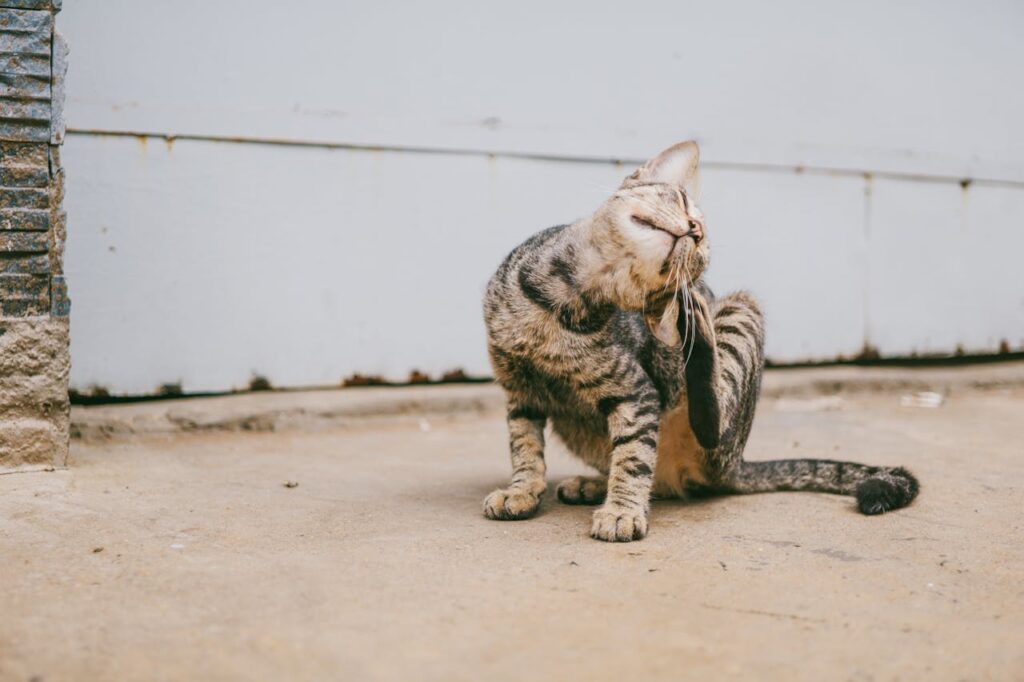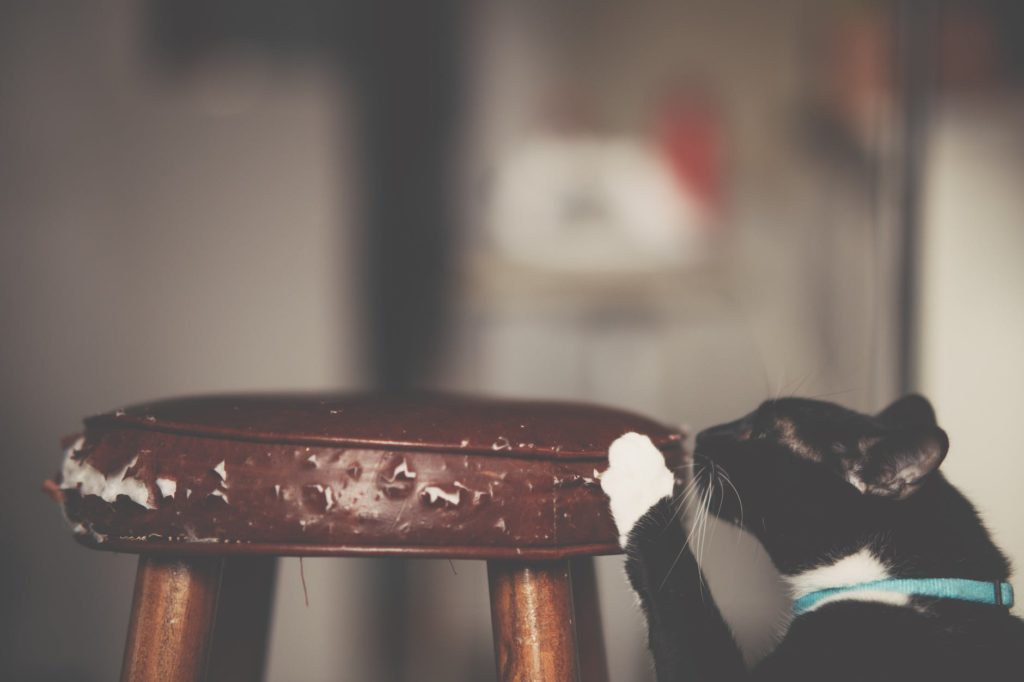Stop Your Cat From Scratching The Furniture
Are you tired of finding your furniture scratched and destroyed by your furry friend? It’s a common problem for cat owners, but it doesn’t have to be! There are plenty of ways to deter your cat from scratching furniture and redirect their attention to more appropriate areas. In this article, we’ll cover some effective strategies for stopping your cat from scratching the furniture.

Table of Contents
Introduction: Understanding Your Feline Friend
Cats are wonderful companions, often known for their playful attitudes and charming antics. However, their natural instinct to scratch can become a significant problem, especially when it leads to damage to your beloved furniture. It’s important to recognize that scratching is a fundamental and essential behavior for cats, serving purposes such as marking territory, toning muscles, and keeping their claws healthy. But fret not! With the right strategies, you can stop your cat from scratching the furniture and redirect that behavior to more appropriate outlets.
In this blog post, we will explore ten powerful tips that can efficiently help you manage your cat’s scratching habits while maintaining your furniture’s integrity. You may find these techniques not only effective but also surprisingly simple to implement. Let’s dive into the strategies that will help you achieve a harmonious home environment.
1. Invest in Quality Scratching Posts
One of the most straightforward ways to stop your cat from scratching the furniture is to invest in high-quality scratching posts. A good scratching post is sturdy and tall enough to allow your cat to stretch fully while scratching. Additionally, it should have a texture that appeals to your cat, such as sisal, carpet, or cardboard.
Cats scratch to fulfill their need to stretch and keep their claws healthy, so a scratching post that mimics the surfaces they naturally gravitate towards can be highly effective. Look for a variety of sizes and styles, as some cats prefer tall vertical posts, while others may prefer horizontal surfaces. Stop Your Cat From Scratching The Furniture. Stop Your Cat From Scratching The Furniture. Once you’ve made an investment, strategically place these posts around your home—especially near places where your cat frequently scratches the furniture.
2. Use Attractants to Encourage Scratching
While placing scratching posts is essential, encouraging your cat to use them over your furniture is equally important. To do this, consider using attractants such as catnip or catnip-infused sprays. Sprinkling catnip on scratching posts can entice your cat to use them instead of the sofa or chair.
Moreover, you might also consider employing toys that encourage play around the scratching post. Stop Your Cat From Scratching The Furniture. This dual approach not only creates a positive association with the scratching post but also provides your cat with added stimulation and exercise. Establishing a routine where your cat feels rewarded for using the scratching post can dramatically shift its focus from your furniture.
3. Make Furniture Less Appealing
Sometimes, all it takes to stop your cat from scratching the furniture is to make the furniture less appealing as a scratching surface. There are several ways to do this effectively. First, consider using double-sided tape on the areas of the furniture your cat usually targets. Cats dislike the sticky feeling on their paws, which can deter them from scratching.
Additionally, you can use furniture covers, slipcovers, or even protective sprays that may discourage scratching. Stop Your Cat From Scratching The Furniture. These barriers not only protect your furniture but also serve as a visual reminder to your cat that it’s not a scratch-friendly zone. Combine this with proactive training, and you may see a significant change in your cat’s behavior.
4. Regularly Trim Your Cat’s Claws
Maintaining your cat’s claws is a proactive measure that can help minimize the damage caused by scratching. Regular trims can significantly reduce the impact of scratches on your furniture. Stop Your Cat From Scratching The Furniture. If you are unsure how to trim your cat’s claws, consult your veterinarian or a professional groomer for guidance, or watch tutorials to learn the best techniques.
In addition to reducing potential damage, regular trimming can also help the claws stay healthy and prevent snagging, which may result in discomfort for your feline friend. By incorporating claw maintenance into your routine, you not only care for your furniture but also contribute to your cat’s overall well-being.
5. Implement Positive Reinforcement Training
Training your cat with positive reinforcement can help curb destructive behaviors like scratching furniture. Stop Your Cat From Scratching The Furniture. Start by observing your cat’s behavior and promptly rewarding them when they choose to scratch their designated post instead of your furniture.
Use treats, praise, or even interactive play as incentives to redirect your cat’s natural instincts. By associating the scratching post with positive experiences, your cat will learn to favor that area. Stop Your Cat From Scratching The Furniture. This method is not only effective but also strengthens the bond between you and your cat, as it encourages a trusting relationship.
6. Create a Dedicated Space for Scratching
Cats are territorial animals, and having a designated space for them to scratch can significantly influence their behavior. Stop Your Cat From Scratching The Furniture. By providing an area specifically for their scratching needs, you encourage them to use it instead of your furniture.
You can create this dedicated scratching area using various scratching surfaces, along with their favorite toys. Ensure this area is easily accessible and perhaps near a favorite resting spot. By offering a space that caters to their instinctual needs, you empower them to express their natural behaviors in an acceptable manner.
7. Utilize Deterrent Sprays
In conjunction with physical barriers and positive reinforcement, utilizing deterrent sprays can be an effective method to dissuade your cat from scratching furniture. Stop Your Cat From Scratching The Furniture. Many commercial sprays contain scents that cats find unpleasant, making them less likely to target those areas.
When using deterrent sprays, it’s essential to test them out first, as some cats may react differently to certain scents. Apply the deterrent to the furniture regularly while simultaneously encouraging your cat to use their scratching posts. Stop Your Cat From Scratching The Furniture. Over time, your cat will learn to avoid the furniture while developing a preference for scratching the posts.
8. Consider Behavioral Products
There are a range of behavioral products designed to help manage a cat’s scratching instincts. Soft nail caps, for instance, are small plastic covers that can be placed over your cat’s claws. They reduce the potential for damage to your furniture while still allowing your cat to engage in its natural scratching behavior.
Additionally, pheromone diffusers can create a calming environment that may also help alleviate any stress causing your cat to scratch out of anxiety. Stop Your Cat From Scratching The Furniture. By leveraging these products, you equip yourself with tools that can help mitigate scratching while maintaining a harmonious living space for both you and your feline companion.
9. Provide Interactive Playtime
Cats need mental and physical stimulation to remain happy and healthy. One of the most effective ways to stop your cat from scratching the furniture is to ensure they receive ample exercise and interaction. Engage your cat with interactive playtime using feather wands, laser pointers, or other toys that stimulate their natural hunting instincts.
When cats are active and stimulated, they are less likely to seek out furniture for scratching due to boredom or excess energy. By incorporating regular play sessions into your daily routine, you not only deter destructive behavior but also enhance your cat’s overall quality of life.
10. Enlist Help if Necessary
If you have tried various methods to stop your cat from scratching the furniture without success, consider seeking professional help. Animal behaviorists or trainers can offer insights tailored specifically to your cat’s personality and behavior patterns.
A trained expert can help identify underlying issues contributing to your cat’s scratching habits and assist in developing a customized plan to address the problem effectively. Sometimes, having an outside perspective can lead to breakthroughs that you may not have considered, leading to a peaceful coexistence with both your furniture and your feline friend.
Enjoying a Scratch-Free Home
In summary, stopping your cat from scratching the furniture may require a multifaceted approach, combining investments in tools, positive reinforcement, and environmental adjustments. By understanding your cat’s needs and instincts, you can redirect their scratching behavior to suitable surfaces, leading to a happier and healthier relationship with your pet.
Explore each of these tips thoughtfully, and remember that patience and consistency are key. With time and effort, you can successfully stop your cat from scratching the furniture, ensuring that both your furry friend and your home coexist harmoniously.
Provide your cat with scratching posts
Cats need to scratch, and if you don’t provide them with a designated area to do so, they’ll choose their own spot – which may be your furniture, curtains, or even your favorite pair of shoes. To prevent any damage and to keep your home looking its best, it’s essential to invest in a few scratching posts placed in various locations throughout your home.
When selecting scratching posts, ensure they are tall enough for your cat to stretch out fully, as this type of physical activity is vital for their health and well-being. Stop Your Cat From Scratching The Furniture. A sturdy design is also important; you want something that won’t topple over when your cat decides to go all out on their scratching spree. To encourage your cat to use the scratching posts, consider sprinkling a little catnip on them. This can be an effective way to attract your cat’s attention and promote positive scratching behavior.
Additionally, observe your cat’s preferences. Some cats may prefer vertical posts, while others enjoy horizontal surfaces, so providing a variety of styles can help cater to their individual scratching habits. Stop Your Cat From Scratching The Furniture. By offering these designated outlets for scratching, you can help maintain your furniture’s integrity while keeping your cat happy and healthy.
Use a deterrent spray
There are many specialized sprays on the market designed specifically to deter cats from unwanted scratching of furniture. These deterrent sprays typically contain natural scents that cats find particularly unpleasant, such as citrus, lavender, or even bitter apple. Stop Your Cat From Scratching The Furniture. The unpleasant aroma works to discourage your furry friend from revisiting those precious scratching spots on your beloved couch or chair.
To effectively use a deterrent spray, start by identifying the areas of furniture that your cat frequently targets. Once you’ve pinpointed these hotspots, generously spray the deterrent on those surfaces. It’s important to follow the instructions on the label, as some sprays may require reapplication after a certain period or after cleaning the surface.
In addition to using the spray, consider combining this approach with positive reinforcement. Redirect your cat’s scratching behavior to appropriate surfaces, such as designated scratching posts or pads. Stop Your Cat From Scratching The Furniture. You can entice them with catnip or rewarding them with treats when they use the scratching posts. By creating a consistent routine of using deterrent spray and providing suitable alternatives, you can help protect your furniture while keeping your cat happy and content. Regularly reassess the effectiveness of the spray, and adjust your strategy as needed for optimal results.
Cover the furniture
If your cat has a particular affinity for a certain piece of furniture, consider covering it with a sheet or blanket when you’re not using it. This simple yet effective strategy can really help in protecting your cherished belongings. Stop Your Cat From Scratching The Furniture. By draping a soft cover over couches, chairs, or any other favorites of your feline friend, you not only deter your cat from scratching or clawing at the upholstery, but you also keep the furniture clean and safe from pet hair and dirt.
Choosing a breathable fabric, such as cotton or linen, can help ensure that the covered furniture remains ventilated and doesn’t develop any unpleasant odors. Moreover, using attractive and decorative covers can also enhance your living space, giving it a refreshed look while serving a functional purpose. Stop Your Cat From Scratching The Furniture. You might even want to switch out covers periodically to keep things interesting for both you and your pet.
This proactive approach can be especially useful during times of extended absence, like vacations or long workdays, when you want to minimize wear and tear. Stop Your Cat From Scratching The Furniture. With just a little extra effort, you can maintain your furniture in good condition and create a more harmonious environment between your cat and your home.

Provide alternative surfaces
Some cats have distinct preferences when it comes to scratching surfaces, often leaning towards horizontal options like carpet or rugs. If this describes your feline friend, it’s essential to cater to their needs by providing a designated scratching mat or rug. Look for durable materials that can withstand vigorous scratching while also being appealing to your cat. Stop Your Cat From Scratching The Furniture. Consider textures that mimic natural scratching environments, such as sisal or cardboard, which many cats find desirable. These surfaces encourage scratching behavior and can divert their attention from your carpets or furniture.
Additionally, you can enhance your strategies to protect existing carpets. For instance, placing double-sided tape on areas where your cat frequently scratches can be quite effective, as the sticky texture tends to deter most cats. Stop Your Cat From Scratching The Furniture. They instinctively avoid surfaces that feel unpleasant on their paws. It’s also beneficial to offer a variety of scratching options around your home, such as vertical scratchers, to see which ones resonate best with your cat’s preferences. Observe their behavior and be patient, as they may need time to adjust to new surfaces. With the right alternatives, you can create a satisfying scratching environment that keeps both your cat happy and your home intact.
Trim your cat’s nails
Trimming your cat’s nails is an essential part of grooming that can enhance their well-being and protect your home. Regular nail trims can significantly minimize the damage your cat does when they scratch furniture or other surfaces. Stop Your Cat From Scratching The Furniture. By keeping their claws short, you also reduce the risk of painful nail-related injuries for your feline friend.
When preparing to trim your cat’s nails, it’s best to use a pair of cat-specific nail clippers, which are designed to provide a clean cut without splintering. Be cautious and avoid cutting into the quick, the sensitive pink area within the nail that contains blood vessels and nerves. Stop Your Cat From Scratching The Furniture. Cutting the quick can be painful and may cause bleeding, so it’s vital to approach this task with care and precision.
If you’re unsure about how to trim your cat’s nails properly, don’t hesitate to consult with your veterinarian, who can provide guidance and demonstrate the technique. You may also seek assistance from a professional groomer. Stop Your Cat From Scratching The Furniture. Additionally, it can be beneficial to start trimming your cat’s nails at a young age so they become accustomed to the process, making it easier in the long run to maintain their nail health and comfort.
Use positive reinforcement
When your cat uses their scratching post or designated scratching area, be sure to praise them and give them a treat. This positive reinforcement will help them associate scratching in the appropriate areas with good things, making them more likely to continue using those areas in the future. Stop Your Cat From Scratching The Furniture. Cats are naturally inclined to scratch to maintain their claws, stretch their muscles, and mark their territory. By providing a suitable scratching option, you are not only promoting good behavior but also enhancing their overall well-being.
To further encourage this behavior, observe your cat closely and reward them immediately after they scratch the post. This immediate response helps them make a stronger connection between their action and the reward. Stop Your Cat From Scratching The Furniture. You can also use a variety of treats to keep your cat engaged and motivated. Experimenting with different scratching surfaces, such as cardboard, carpet, or sisal, can also help you find what your cat prefers, making them more inclined to use it.
Remember, consistency is key; ensure all family members are on board with the reinforcement strategy. Over time, your cat will learn that using the scratching post is not only acceptable but also a fantastic way to gain attention and treats. This positive relationship with scratching will lead to a happier, more balanced pet.
Live Pee Free! Odor Eliminator 100% Eliminates Pet Odor on Contact. 20% Off. No Enzymes, No Fragrance, No Detergent, No Bleach – Safe for Kids and Pets.Consider soft paws
If all else fails, consider using soft paws—small, plastic caps that fit over your cat’s nails. These caps are designed to be safe and painless, offering a practical solution to minimize the damage your cat causes when they scratch. Unlike declawing, which can be traumatic and painful for felines, soft paws allow your cat to retain their natural behaviors while protecting your furniture. Stop Your Cat From Scratching The Furniture.
Soft paws come in various sizes to fit different breeds and are typically made from non-toxic materials. They can help alleviate the stress and frustration that comes with dealing with a scratch-happy kitty. The application process is simple; you can easily glue the caps onto your cat’s nails, and they will typically stay in place for several weeks, depending on your cat’s activity level.

It’s important to check the caps regularly, as they may need to be replaced every few weeks. Regular grooming and nail trimming will also help maintain your cat’s paws and keep them comfortable. Overall, soft paws can be an excellent alternative for cat owners who want to protect their furniture while ensuring their furry friends remain happy and healthy. With a little patience and practice, you can find the right balance for both you and your cat.



